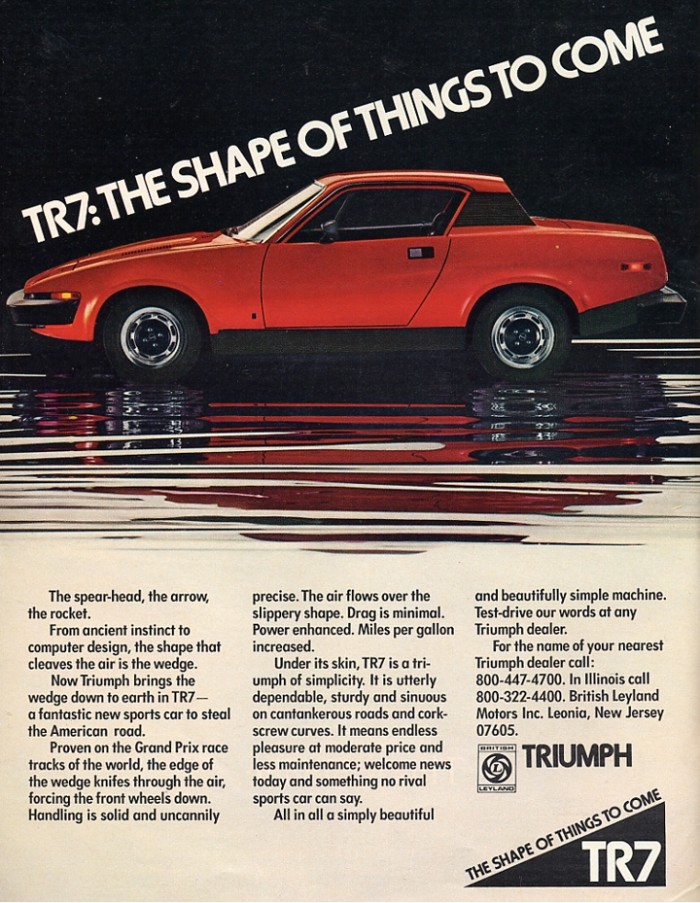The Shape of Things To Come: Remembering Triumph’s TR7
Posted on Mar 24, 2015 in Featured | 2 comments

1975 Triumph TR7.
Introduced in 1975, Triumph’s TR7 coupe (and later, convertible) represented a bold new styling direction for the British automaker, whose other coupe and convertible offerings (the GT6 Mk III, the Spitfire and the TR6) were beginning to show their age. With a distinctive and futuristic wedge shape, penned by Harris Mann, the TR7 put the company back into the spotlight, and accomplished its mission of drawing sports car buyers back into Triumph showrooms.
As described in this print ad from the TR7’s first year on the market, the car’s slippery shape “knifes through the air, forcing the front wheels down,” for “solid” and “uncannily precise” handling. The low-drag shape had another benefit, too: enhanced fuel economy, a major selling point to buyers with vivid memories of fuel shortages and drastic gas price increases. Triumph also heralded the car’s simplicity and affordability, reassuring buyers that, though the car looked expensive, parking one in the garage wouldn’t break the bank.

The car was well received by period print magazines, which praised its “spacious and luxurious” interior, along with its nimble handling. Motor Trend rated the TR7’s cornering in the same league as the Ferrari Dino’s and Lotus Europa’s, big shoes to fill for a car aimed at a significantly lower price point. TR7s did well on the race track, too, capturing an SCCA divisional championship in 1976 and following this up with three more in 1977, just a few of the motorsport trophies in the TR7’s showcase. Given all the car had going for it, it’s easy to understand why, at 141,232 units sold (including coupes and convertibles), the TR7 was the best-selling Triumph TR model of all time.
That’s not to say the TR7 was without its flaws. Thanks to disputes between management and workers, punctuated by frequent strikes and walkouts at the Speke factory, build quality was legendarily spotty. Later production models, especially those assembled at Canley or Solihull, proved to be better assembled, but by then, the damage had been done to the car’s reputation. In a semi-infamous piece penned for Time magazine by automotive journalist Dan Neil, the TR7 was named to a list of “The 50 Worst Cars of All Time.”
Was the car deserving of such harsh criticism? Given that it remained in production until 1981, launched a convertible version and a later V-8 powered variant, the answer is “probably not.” In October of 2013, Hemmings Sports & Exotic Car editor David LaChance spent a week living with a borrowed TR7, and found it to be a pleasant overall experience. Despite a few instances of the car’s “personality” shining through (an oil pressure light, traced to a water-induced short in heavy rain, and a coolant light, indicating low coolant in the overflow tank), David proclaimed the TR7 “an excellent commuter” for his daily round trip.
Perhaps less appreciated than other Triumph models, TR7s remain affordable, and by now, any survivors are likely well-sorted. While they didn’t truly prove to be “the shape of things to come,” Triumph’s penultimate model deserves to be remembered as much for its successes as its perceived failures.





I read a book on the development, building and selling of the TR7-the stories of how poisonous the enviroment was at Speke are unbelievable. I think it was TR7 The Untold Story–read it and form your own opinion how the British auto industry died.
The British Auto industry is very much alive and exporting lots of cars. What died is some British motor car manufacturers, the industry is doing better than ever, the cars it exports are called Toyota, Nissan, Mini, Vauxhall, Jaguar, Land Rover and Ford, and there are many of them.